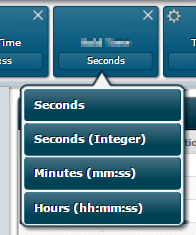Accepted Duration
This data export field displays the elapsed time measured between setup and the 'Ringing' or 'Progress' message received by the caller.
See also, Call Duration Charts.
|
Historical Data Source |
CONTACT Data Records |
|
Category |
Basic |
|
Channels |
|
|
Size (bytes) |
8 |
|
Filter |
None |
|
Dimension |
None |
Format
By clicking the current duration format, you can select another format, which may be more appropriate for your report.
 |
|
The 'Seconds' format shows decimal places; the 'Seconds (Integer)' format does not. |
Example
This data export report shows an outgoing call to a mobile number. The field value is written to the outbound leg of the call.
|
Accepted Duration |
||||
|
2018-01-17 12:06:17 |
I |
0 |
iPath_129_cmilliband |
Craig Millband |
|
2018-01-17 12:06:19 |
O |
2.1 |
01344304344 |
|
Detail
The data export field populates the inbound (I) and outbound (O) legs in interaction scenarios as illustrated below. See also, Communication Legs.
|
|
External |
storm |
storm user |
|
|
Deskphone LOG IN and LOG OUT |
Always 0 |
|
|
Always 0 |
EXTERNAL INCOMING CALL (2 legs) |
|
|
|
OUTGOING CALL dialled directly from deskphone or storm DTA Web iPath (1st leg) |
Always 0 |
|
|
or OUTGOING CALL initiated from the agent desktop (DTA) (1st leg) |
Always 0 |
||
|
Initial called party leg (2nd leg) |
|||
|
|
|
|
TRANSFER of an INCOMING or OUTGOING CALL Transfer leg (3rd and subsequent legs) |
||
|
|
Either a 'Ringing' or a 'Progress' message is sent. A 'Progress' message usually means that early media is being played before the call is connected. This media is typically a dial tone or a prompt. A prompt is a recorded message informing the caller about something. For example, it might state that the call may be recorded or that the number is a premium rate number.
To a caller, Accepted Duration and Ringing Duration may be considered the same with the caveat that the caller may not have heard any ring tone.
Note: values of 0 are written to all communication legs of non-voice interactions.






